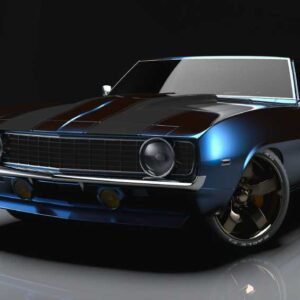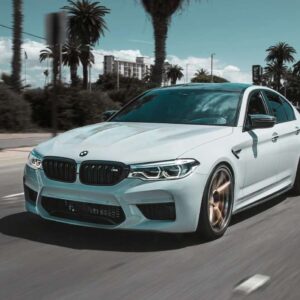When it comes to the silver screen, cars often play a starring role alongside their human counterparts. They have the power to steal the scene, leaving an indelible mark on our cinematic memories. From sleek sports cars to rugged classics, here are the top 5 iconic cars in cinema history that have revved their engines into our hearts.
DeLorean DMC-12 in “Back to the Future”
“Back to the Future” is a time-traveling adventure that has captured the hearts of generations, and one of its most unforgettable characters is not a person, but a car—the DeLorean DMC-12. This iconic stainless steel beauty, with its gull-wing doors, is a time machine built by the eccentric Doc Brown.
The DeLorean’s futuristic appearance, with its brushed stainless steel body and unique door design, made it an instant automotive legend. While the car’s actual performance didn’t quite match its looks in reality, on-screen, it soared through time, leaving fiery tire tracks behind. The DeLorean’s role as a time machine was central to the film’s plot, and its distinctive look added to the movie’s charm.
Notable scenes involving the DeLorean include the unforgettable clock tower climax and the exhilarating highway chase. The DeLorean’s role was pivotal to the story, and its presence on screen is etched into cinematic history.
1963 Aston Martin DB5 in “Goldfinger”
James Bond is known for his sophisticated tastes, and perhaps no car embodies that elegance and style better than the 1963 Aston Martin DB5 in “Goldfinger.” This luxurious sports car, equipped with gadgets like machine guns and an ejector seat, was the perfect match for the suave secret agent.
The DB5’s appearance is timeless, with its sleek silver exterior and iconic grille. Its role in the film was as Bond’s trusty getaway car and an integral part of his arsenal. The car’s gadgets added a thrilling element of suspense and humor to the film, making it a fan favorite.
Notable scenes include the high-speed chase through the Swiss Alps and the memorable moment when Bond activates the ejector seat to dispatch an unwelcome passenger. The DB5 became so closely associated with Bond that it appeared in several subsequent films, solidifying its place in cinematic history.
1970 Dodge Challenger R/T in “Vanishing Point”
“Vanishing Point” is a cult classic that showcases the raw power of the 1970 Dodge Challenger R/T. This iconic American muscle car, with its bold design and roaring engine, becomes the symbol of freedom and rebellion in the film.
The Challenger R/T’s appearance is all muscle, with its aggressive front grille, sleek lines, and unmistakable shaker hood scoop. In the film, it serves as the ultimate escape vehicle for the enigmatic Kowalski, a car delivery driver on a high-speed race against time and the law.
Notable scenes involving the Challenger R/T include the adrenaline-pumping cross-country chase and the dramatic climax at the film’s conclusion. The car’s representation of freedom and defiance has made it an enduring symbol of the American dream and counterculture.
1977 Pontiac Firebird Trans Am in “Smokey and the Bandit”
If there’s one car that defined ’70s cool, it’s the 1977 Pontiac Firebird Trans Am driven by Burt Reynolds in “Smokey and the Bandit.” This iconic black and gold muscle car was as charismatic as its driver.
The Firebird Trans Am’s appearance is instantly recognizable, with its bold hood decal and sleek profile. In the film, it serves as the Bandit’s high-speed, high-stakes escape vehicle as he takes on the law enforcement pursuit led by Sheriff Buford T. Justice.
Notable scenes include the exhilarating chases and the charismatic banter between the Bandit and his co-driver, Cledus. The Firebird Trans Am became a symbol of rebellion and adventure, capturing the spirit of the ’70s and earning its place in automotive and cinematic history.
1969 Ford Mustang in “Bullitt”
“Bullitt” is known for its groundbreaking car chase scenes, and at the center of the action is a 1969 Ford Mustang GT Fastback. Driven by the iconic Steve McQueen, this muscle car showcased the epitome of coolness and determination.
The Mustang’s appearance is classic American muscle, with its bold front grille and sleek lines. In the film, it serves as the no-nonsense detective Frank Bullitt’s pursuit vehicle as he takes on the criminal underworld of San Francisco.
Notable scenes include the legendary car chase through the hilly streets of San Francisco, a sequence that set a new standard for cinematic car chases. The Mustang’s role in “Bullitt” solidified its place as one of the most iconic cars in cinema history.
Realism vs. Dramatic Effect
While these iconic cars often take center stage, it’s worth noting that realism isn’t always a top priority in cinema. Filmmakers prioritize dramatic effect and storytelling over accurate automotive details. Moviegoers suspend disbelief to fully immerse themselves in the cinematic experience, understanding that real-life car repair and maintenance wouldn’t always cut it for the big screen.
Car Repair and Maintenance in Cinema
In the thrilling realm of cinema, cars routinely break free from the confines of physical laws and logic, displaying a remarkable ability to recover miraculously from catastrophic damage that would leave real-life mechanics utterly astonished. It’s almost as though these cinematic vehicles possess an ethereal resilience, nonchalantly enduring the most heart-stopping stunts and explosive crashes.
Picture a high-speed chase unfolding amid a bustling cityscape—cars careen off ramps, plow through fruit stands, and execute barrel rolls that would put a gymnast to shame. In these adrenaline-pumping moments, vehicles face a level of punishment that would render most real-world cars irreparably damaged. Calculating the repair cost for the vehicular mayhem witnessed on screen would likely make even the most budget-conscious individual cringe.
Now, consider a scenario closer to everyday life: you’re a devoted car owner who adores your vibrant red sports car. One day, your heart sinks as you discover an unsightly scratch marring its side. In the movies, fixing such blemishes appears effortless, with a touch-up pen magically erasing the imperfection in an instant. But the reality is far from straightforward. You’d have to navigate the complexities of insurance, file a police report, and eventually the need for a professional automotive paint repair. The looming car paint repair cost becomes a stark reminder that real-world car repairs can be time-consuming and financially draining, in stark contrast to the swift solutions seen on screen.
Nonetheless, it’s crucial to remember that the world of cinema operates under its own unique set of rules, where the boundaries of reality are intentionally stretched to their limits. Filmmakers prioritize crafting an immersive experience for the audience and weaving compelling narratives over dwelling on the mundane intricacies of car maintenance and repair. Consequently, cars in movies often emerge from their tumultuous ordeals with an inexplicably pristine appearance, seemingly untouched by the chaos they’ve just weathered.
Conclusion
These top 5 iconic cars in cinema history have left an indelible mark on the world of film, becoming as famous as the characters who drove them. From time-traveling DeLoreans to gadget-packed Aston Martins, these cars are more than just modes of transportation—they are symbols of adventure, rebellion, and style.
In the world of cinema, realism often takes a backseat to dramatic effect, allowing these iconic cars to perform incredible feats and defy the laws of automotive repair and maintenance. While real-world car enthusiasts might cringe at the thought of the car paint repair cost for some of the on-screen damage, it’s all part of the magic of the movies.
So, the next time you watch one of these classic films, keep an eye out for these iconic cars and appreciate the role they play in cinematic history. After all, they’re not just cars; they’re legendary stars in their own right.





